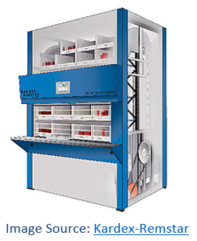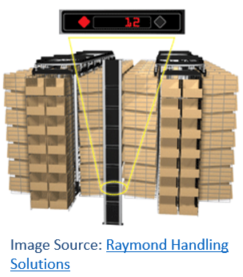 By Ian Hobkirk
By Ian Hobkirk
Managing Director of Commonwealth Supply Chain Advisors
Under increasing pressure to work faster, better, and smarter in today’s omni-channel and e-commerce business environment, companies need help getting their distribution operations up to speed with customer demands and expectations. To help, Commonwealth Supply Chain Advisors has identified 10 key tactics that successful companies are employing in order to make a graceful transition to higher levels of e-commerce in the distribution center.
In Parts I1 through 4 of this ten-part blog series, I covered the four basic tactics: Create a Forward Pick Area, Setup Effective Replenishment, Determine Overall Pick Strategy and Determine the Optimal Pick Methodology. Parts 5 through 7 focused on the Intermediate Tactics: Practice Real-Time Warehousing, Optimizing Packing, and Manage Parcel Shipments Effectively. Part 8 embarked on the first of the three Advanced Tactics: Pick-to-Shipping Container and this blog, part 9, explores Goods-to-Picker Systems as the second Advanced Strategy.
Tactic #9: Employ Goods-to-Picker Systems
Eventually, if piece-pick requirements increase to a certain level, then goods-to-picker systems may make sense as a means of reducing pick labor (and improving space utilization). While good cart-based systems can produce pick rates of between 100 and 200 lines per hour, goods-to-picker systems have been known to allow rates of 400–600 lines per hour.
Goods-to-picker systems are available as many different forms of technology. A company’s choice of a system should be driven by:
• Throughput requirements
• Product makeup
• Order profiles
• Space requirements
• Budgetary limitations
• Flexibility needs
Some of the major forms of goods-to-picker systems include:
Horizontal Carousels
 These systems produce very high pick rates but are not as space-effective as other technologies. Creative use of mezzanines and lift tables can extend the working height of these systems and make better use of cube. Successful horizontal carousel systems require that multiple units be grouped in a pod, where a single picker works multiple machines at the same time. This necessitates the use of sophisticated software to plan and execute each batch of orders that are picked. Unfortunately, over the last several decades, the mechanical designs of horizontal carousels evolved at a faster rate than the requisite software capabilities, and as a result many horizontal carousels systems were installed in the 1980’s and 1990’s, which failed to meet expectations. Some supply chain executives have a bad taste in their mouths from this situation; these individuals can take comfort in the improved software capabilities that have arisen in recent years. There are many, many examples of successful systems in a wide variety of industries.
These systems produce very high pick rates but are not as space-effective as other technologies. Creative use of mezzanines and lift tables can extend the working height of these systems and make better use of cube. Successful horizontal carousel systems require that multiple units be grouped in a pod, where a single picker works multiple machines at the same time. This necessitates the use of sophisticated software to plan and execute each batch of orders that are picked. Unfortunately, over the last several decades, the mechanical designs of horizontal carousels evolved at a faster rate than the requisite software capabilities, and as a result many horizontal carousels systems were installed in the 1980’s and 1990’s, which failed to meet expectations. Some supply chain executives have a bad taste in their mouths from this situation; these individuals can take comfort in the improved software capabilities that have arisen in recent years. There are many, many examples of successful systems in a wide variety of industries.
Vertical Carousels
 Vertical carousels typically do not produce the same high pick rates as their horizontal cousins, but can still often exceed rates from cart-based systems. Vertical carousels excel when space utilization is the dominant design factor. The full height of a building can be typically utilized for storage while the picker remains on the floor level. Like horizontal carousels, software and system design are key to ensure that operators can pick from multiple units at the same time. It is also important that the parts stored in vertical carousels be somewhat uniform in size and height.
Vertical carousels typically do not produce the same high pick rates as their horizontal cousins, but can still often exceed rates from cart-based systems. Vertical carousels excel when space utilization is the dominant design factor. The full height of a building can be typically utilized for storage while the picker remains on the floor level. Like horizontal carousels, software and system design are key to ensure that operators can pick from multiple units at the same time. It is also important that the parts stored in vertical carousels be somewhat uniform in size and height.
Vertical Lift Modules
From the outside, Vertical Lift Modules (VLMs) appear very similar to vertical carousels, but their operation is very different. A big advantage that VLMs have in this case is their ability to accept items of varying sizes and heights. VLMs are not quite as space efficient as vertical carousels due to the large extractor shaft in the center of the unit as well as lost space from the access window, but these disadvantages start to lessen as storage heights increase. Like vertical carousels, VLMs should be considered in areas that are space-constrained.
Automated Storage and Retrieval Systems (AS/RS)
AS/RS is an entire category of its own, and comprised of a variety of products which each work slightly differently. The major categories include pallet-handling and case-handling systems, with many varieties even within these categorizations. Common characteristics involve an extractor device of some kind retrieving a load and bringing it to an operator for picking.
Related Reading on how AS/RS can save space: “Six Ways to Postpone Your Warehouse Expansion.”
In the next and final installment of this ten-part blog series we’ll discuss the third Advanced Topic: Improve wave Management.
